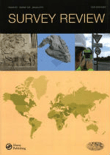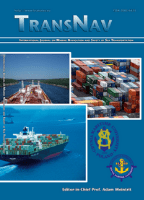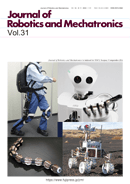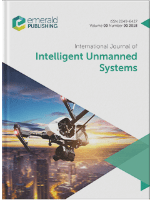
Navigation-Journal of the Institute of Navigation
Scope & Guideline
Exploring Cutting-Edge Technologies in Navigation
Introduction
Aims and Scopes
- Global Navigation Satellite Systems (GNSS):
Research on GNSS encompasses topics such as signal processing, accuracy enhancement, and interference mitigation, addressing the challenges and advancements in satellite-based navigation. - Sensor Integration and Fusion:
The journal highlights studies that integrate GNSS with other sensor modalities, such as inertial navigation systems (INS), to improve positioning accuracy and resilience in challenging environments. - Positioning Techniques and Algorithms:
Papers often discuss novel algorithms and methodologies for precise positioning, including real-time kinematic (RTK) methods, precise point positioning (PPP), and advanced filtering techniques like Kalman filtering. - Impact of Environmental Factors on Navigation:
Research in this area focuses on how environmental conditions, such as ionospheric disturbances and urban canyons, affect GNSS performance, leading to the development of mitigation strategies. - Emerging Navigation Technologies:
The journal includes studies on new technologies such as quantum navigation, machine learning applications in navigation, and the development of alternative positioning systems. - Safety and Integrity Monitoring:
Integrity monitoring and safety assessments in navigation systems are critical themes, ensuring that navigation solutions are reliable, particularly in sectors like aviation and autonomous vehicles.
Trending and Emerging
- Machine Learning and Artificial Intelligence in Navigation:
Recent publications highlight the application of machine learning and AI techniques to improve GNSS accuracy, signal processing, and anomaly detection, marking a significant trend in research methodologies. - Resilience and Robustness in Navigation Systems:
There is a growing interest in enhancing the resilience of navigation systems against interference and environmental challenges, particularly through innovative filtering and sensor fusion techniques. - Lunar and Space Navigation Systems:
Emerging research on navigation systems for lunar missions and satellite constellations reflects the expanding interest in space exploration and the unique challenges associated with extraterrestrial navigation. - Cybersecurity in Navigation Systems:
As navigation systems become increasingly interconnected, studies focusing on the security of GNSS signals and anti-spoofing measures are gaining prominence, addressing vulnerabilities in navigation technologies. - Ionospheric and Environmental Modeling:
Research that involves advanced modeling of ionospheric effects and environmental impacts on GNSS performance is trending, as accurate modeling is crucial for improving navigation reliability. - Multi-Constellation GNSS Integration:
The integration of multiple GNSS constellations (e.g., GPS, Galileo, BeiDou) is a key emerging theme, with research focusing on interoperability, signal processing, and improved positioning accuracy.
Declining or Waning
- Traditional GNSS Techniques:
While foundational GNSS techniques remain important, there seems to be a gradual decline in publications focusing solely on conventional methods, as researchers increasingly explore advanced and integrated approaches. - Static Positioning Applications:
Research centered on static positioning has decreased, as the focus shifts to dynamic and mobile applications, particularly in urban environments and for autonomous systems. - Basic Signal Processing Techniques:
The journal has seen fewer papers on basic signal processing techniques, with more emphasis now placed on complex algorithms and machine learning applications that enhance GNSS performance. - Historical Perspectives on GNSS:
Although historical analyses provide valuable insights, there is a noticeable reduction in studies that focus exclusively on historical perspectives of GNSS systems, as the community prioritizes contemporary challenges and innovations.
Similar Journals

Journal of Imaging
Transforming Ideas into Visual RealitiesThe Journal of Imaging, published by MDPI, is an esteemed open-access journal dedicated to advancing the fields of Computer Graphics, Computer Vision, and Electrical Engineering. Since its inception in 2015, this journal has established a significant presence in the academic community, reflected by its impressive rankings in Scopus, including a Q2 quartile in multiple categories such as Computer Vision and Pattern Recognition and Radiology. With a commitment to disseminating high-quality research, the journal offers a platform for innovative studies and practical applications, making it an essential resource for researchers, professionals, and students alike. Operating from its base in Basel, Switzerland, the journal continues to promote scholarly work that pushes the boundaries of imaging technologies, while contributing to the global discourse in its respective fields. The open-access model ensures that valuable research is readily available, fostering collaboration and knowledge-sharing across disciplines.

JOURNAL OF THE ASTRONAUTICAL SCIENCES
Innovating the Future of Planetary ScienceJOURNAL OF THE ASTRONAUTICAL SCIENCES, published by Springer Heidelberg, serves as a leading platform dedicated to advancing the fields of aerospace engineering and planetary science. With an ISSN of 0021-9142 and an E-ISSN of 2195-0571, this journal has established a significant presence within the academic community, evidenced by its categorization in the Q2 and Q3 quartiles for 2023, positioning it among the top publications in its field. The journal encompasses a spectrum of research that spans from innovative aerospace technologies to the exploration of planetary systems, reflecting its rich scope developed since its inception in 1969. Although not Open Access, it provides vital contributions to ongoing discussions in aerospace research, appealing to researchers, professionals, and students eager to deepen their understanding of astronautics. With a notable impact factor and rankings in Scopus—66th in Aerospace Engineering and 64th in Space and Planetary Science—this journal continues to be a pivotal resource for those engaged in the exploration and utilization of space.

SURVEY REVIEW
Exploring Innovations in Earth and Planetary SciencesSURVEY REVIEW is a distinguished journal published by Taylor & Francis Ltd, focusing on a diverse range of disciplines including Civil and Structural Engineering, Computers in Earth Sciences, and Earth and Planetary Sciences. With an ISSN of 0039-6265 and an E-ISSN of 1752-2706, this journal has been a vital resource for scholarly communication since its inception in 1963. Positioned within the Q2 and Q3 quartile categories according to the latest rankings, it is recognized for its significant contributions to advancing knowledge in multiple fields, specifically holding a rank of 64/159 in Earth and Planetary Sciences and 32/73 in Computers in Earth Sciences. Researchers, professionals, and students benefit from its critical insights into complex engineering and scientific challenges. Although SURVEY REVIEW is not open access, it remains a highly cited journal, making it an essential avenue for disseminating pivotal findings that impact both academia and industry practices.

TransNav-International Journal on Marine Navigation and Safety of Sea Transportation
Transforming Maritime Practices with Innovation.TransNav - International Journal on Marine Navigation and Safety of Sea Transportation is a leading scholarly publication that addresses the critical themes of marine navigation and maritime safety. Published by Gdynia Maritime University in Poland, this open-access journal has been a vital resource since its inception in 2007, fostering a global dialogue among researchers, maritime professionals, and students. With an impressive trajectory of convergence from 2019 to 2024, TransNav is recognized for its impact in the realm of Ocean Engineering, Oceanography, and Transportation, holding a notable Q3 ranking in Ocean Engineering and Q4 rankings in both Oceanography and Transportation for 2023. The journal serves as an essential platform for disseminating research findings and advancements that enhance safety protocols and navigation strategies in sea transportation, thus contributing to the sustainability and efficiency of maritime operations worldwide. Researchers can access its wealth of information through various academic databases, ensuring that your work remains on the cutting edge of this vital field.

Unmanned Systems
Connecting Researchers to the Future of Unmanned SystemsUnmanned Systems is a leading academic journal published by WORLD SCIENTIFIC PUBL CO PTE LTD based in Singapore, that serves as a premier platform for research and advancements in unmanned vehicle technology. Covering a broad range of disciplines, the journal ranks in the Q1 category for Aerospace Engineering, Automotive Engineering, Control and Optimization, and Control and Systems Engineering as of 2023, showcasing its high impact within these fields. With impressive Scopus rankings placing it in the top tiers of its categories—8th in Control and Optimization and 14th in Aerospace Engineering—Unmanned Systems stands out as a vital resource for researchers, professionals, and students eager to explore current trends and innovations. While the journal operates under a traditional access model, it remains committed to disseminating quality original research, reviews, and case studies that contribute significantly to the understanding and application of unmanned technologies from 2013 through 2024.

Journal of Robotics and Mechatronics
Innovating Connections Between Theory and ApplicationJournal of Robotics and Mechatronics, published by FUJI TECHNOLOGY PRESS LTD, stands at the forefront of innovation in the fields of robotics and mechatronics. Since its inception in 1989, this Open Access journal has become a vital resource for researchers, professionals, and students interested in advances that merge technology with mechanical systems, offering critical insights into practical applications and theoretical developments. With a commendable impact factor reflected in its Q2 rankings in both Computer Science (miscellaneous) and Electrical and Electronic Engineering, the journal serves as a platform for disseminating high-quality research and fostering academic collaborations. The journal enjoys wide accessibility since transitioning to Open Access in 2007, allowing for a global audience to engage with groundbreaking findings relevant to both industry and academia. Based in Tokyo, Japan, the Journal of Robotics and Mechatronics aspires to bridge the gap between research and practical implementation, encouraging the exploration of novel concepts and the sharing of scientific knowledge.

Journal of Aerospace Information Systems
Innovating at the Intersection of Aerospace and Information SystemsJournal of Aerospace Information Systems, published by the American Institute of Aeronautics and Astronautics, is a premier scholarly platform dedicated to advancing the interdisciplinary field of aerospace information systems. With a focus on innovative research and practical applications, this journal supports the dynamic integration of aerospace engineering, computer science, and electrical engineering. Positioned in Q2 quartiles for 2023 in its respective categories, it ranks notably in Aerospace Engineering (#52/153) and Electrical and Electronic Engineering (#357/797), indicating its significant influence within the scientific community. Research published within its pages addresses a diverse range of technological advancements and applications that are vital for the development of contemporary aerospace systems. As an open-access journal, it facilitates broader dissemination of knowledge, allowing researchers, professionals, and students to engage with cutting-edge discoveries and methodologies. With its competitive impact and commitment to fostering innovation, the Journal of Aerospace Information Systems is an essential resource for anyone involved in the burgeoning field of aerospace technology.

International Journal of Intelligent Unmanned Systems
Advancing the Future of Intelligent Unmanned SystemsInternational Journal of Intelligent Unmanned Systems, published by Emerald Group Publishing Ltd, is a leading platform for research focusing on the advancement of intelligent unmanned technologies. With an ISSN of 2049-6427 and an E-ISSN of 2049-6435, this journal addresses critical topics in Automotive Engineering, Economics, and Mechanical Engineering, reflecting its categorization within the Q3 and Q4 quartiles of 2023. It serves as a crucial resource for academics and professionals involved in developing intelligent unmanned systems, encompassing their application, design, and the economics surrounding these innovations. From its inception in 2013 and continuing through 2024, the journal has carved out an important niche within the research community by providing high-quality, peer-reviewed articles that contribute significantly to operational advancements and theoretical frameworks. This journal not only encourages open dialogue among researchers but also promotes interdisciplinary studies essential for the growth of intelligent systems in various sectors.

Visnyk NTUU KPI Seriia-Radiotekhnika Radioaparatobuduvannia
Shaping Tomorrow's Technologies TodayVisnyk NTUU KPI Seriia-Radiotekhnika Radioaparatobuduvannia is a distinguished open-access journal published by the National Technical University of Ukraine, Kyiv Polytechnic Institute. Since its inception in 2009, the journal has been a vital platform for disseminating innovative research findings in the fields of radio engineering, electronic technology, and the development of radio apparatus. With its commitment to providing unrestricted access to high-quality scientific content, the journal aims to foster collaboration and knowledge exchange among researchers, practitioners, and educators both in Ukraine and globally. While the journal's H-index and Scopus rankings are currently not provided, its growing reputation in the academic community is indicative of its impact in advancing technology and engineering practices. The journal's accessibility ensures that cutting-edge research is available to a wide audience, making it a crucial resource for professionals and students seeking to stay informed about the latest advancements in radio technology and engineering.

IEEE AEROSPACE AND ELECTRONIC SYSTEMS MAGAZINE
Delivering high-impact research for the aerospace community.IEEE Aerospace and Electronic Systems Magazine, published by the IEEE Institute of Electrical and Electronics Engineers Inc, stands as a pivotal resource for scholars and practitioners in the fields of aerospace and electronic systems. With an impressive impact factor and consistently ranking in the top quartiles of its categories, this journal has been dedicated to providing high-quality content since its inception in 1986. Covering a broad spectrum of topics across Aerospace Engineering and Electrical and Electronic Engineering, it garners significant attention, ranked #15 in Aerospace Engineering and #130 in Electrical and Electronic Engineering by Scopus, placing it firmly in the 90th and 83rd percentiles, respectively. The magazine’s commitment to delivering cutting-edge research makes it an essential tool for academicians, industry professionals, and students alike, facilitating advancements in technology and innovation across the globe. Submissions undergo rigorous peer-review, ensuring that only the most relevant and impactful studies contribute to the ongoing dialogue in the aerospace and electronic systems community.